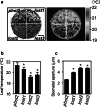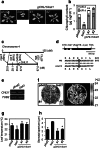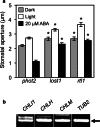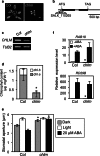Mg-chelatase I subunit 1 and Mg-protoporphyrin IX methyltransferase affect the stomatal aperture in Arabidopsis thaliana
- PMID: 24840863
- PMCID: PMC4683165
- DOI: 10.1007/s10265-014-0636-0
Mg-chelatase I subunit 1 and Mg-protoporphyrin IX methyltransferase affect the stomatal aperture in Arabidopsis thaliana
Abstract
To elucidate the molecular mechanisms of stomatal opening and closure, we performed a genetic screen using infrared thermography to isolate stomatal aperture mutants. We identified a mutant designated low temperature with open-stomata 1 (lost1), which exhibited reduced leaf temperature, wider stomatal aperture, and a pale green phenotype. Map-based analysis of the LOST1 locus revealed that the lost1 mutant resulted from a missense mutation in the Mg-chelatase I subunit 1 (CHLI1) gene, which encodes a subunit of the Mg-chelatase complex involved in chlorophyll synthesis. Transformation of the wild-type CHLI1 gene into lost1 complemented all lost1 phenotypes. Stomata in lost1 exhibited a partial ABA-insensitive phenotype similar to that of rtl1, a Mg-chelatase H subunit missense mutant. The Mg-protoporphyrin IX methyltransferase (CHLM) gene encodes a subsequent enzyme in the chlorophyll synthesis pathway. We examined stomatal movement in a CHLM knockdown mutant, chlm, and found that it also exhibited an ABA-insensitive phenotype. However, lost1 and chlm seedlings all showed normal expression of ABA-induced genes, such as RAB18 and RD29B, in response to ABA. These results suggest that the chlorophyll synthesis enzymes, Mg-chelatase complex and CHLM, specifically affect ABA signaling in the control of stomatal aperture and have no effect on ABA-induced gene expression.
Figures





Similar articles
-
Mg-chelatase H subunit affects ABA signaling in stomatal guard cells, but is not an ABA receptor in Arabidopsis thaliana.J Plant Res. 2011 Jul;124(4):527-38. doi: 10.1007/s10265-011-0426-x. Epub 2011 May 12. J Plant Res. 2011. PMID: 21562844 Free PMC article.
-
A link between magnesium-chelatase H subunit and sucrose nonfermenting 1 (SNF1)-related protein kinase SnRK2.6/OST1 in Arabidopsis guard cell signalling in response to abscisic acid.J Exp Bot. 2015 Oct;66(20):6355-69. doi: 10.1093/jxb/erv341. Epub 2015 Jul 13. J Exp Bot. 2015. PMID: 26175350 Free PMC article.
-
Roles of the different components of magnesium chelatase in abscisic acid signal transduction.Plant Mol Biol. 2012 Nov;80(4-5):519-37. doi: 10.1007/s11103-012-9965-3. Epub 2012 Sep 27. Plant Mol Biol. 2012. PMID: 23011401 Free PMC article.
-
New approaches to the biology of stomatal guard cells.Plant Cell Physiol. 2014 Feb;55(2):241-50. doi: 10.1093/pcp/pct145. Epub 2013 Oct 7. Plant Cell Physiol. 2014. PMID: 24104052 Free PMC article. Review.
-
Seeing 'cool' and 'hot'--infrared thermography as a tool for non-invasive, high-throughput screening of Arabidopsis guard cell signalling mutants.J Exp Bot. 2004 May;55(400):1187-93. doi: 10.1093/jxb/erh135. Epub 2004 Apr 8. J Exp Bot. 2004. PMID: 15073209 Review.
Cited by
-
CHLH/GUN5 Function in Tetrapyrrole Metabolism Is Correlated with Plastid Signaling but not ABA Responses in Guard Cells.Front Plant Sci. 2016 Nov 7;7:1650. doi: 10.3389/fpls.2016.01650. eCollection 2016. Front Plant Sci. 2016. PMID: 27872634 Free PMC article.
-
Perspectives on improving light distribution and light use efficiency in crop canopies.Plant Physiol. 2021 Feb 25;185(1):34-48. doi: 10.1093/plphys/kiaa006. Plant Physiol. 2021. PMID: 33631812 Free PMC article.
-
A novel semi-dominant mutation in brassinosteroid signaling kinase1 increases stomatal density.Front Plant Sci. 2024 Apr 2;15:1377352. doi: 10.3389/fpls.2024.1377352. eCollection 2024. Front Plant Sci. 2024. PMID: 38628368 Free PMC article.
-
Arabidopsis HY1-Modulated Stomatal Movement: An Integrative Hub Is Functionally Associated with ABI4 in Dehydration-Induced ABA Responsiveness.Plant Physiol. 2016 Mar;170(3):1699-713. doi: 10.1104/pp.15.01550. Epub 2015 Dec 24. Plant Physiol. 2016. PMID: 26704641 Free PMC article.
-
Protease Inhibitor-Dependent Inhibition of Light-Induced Stomatal Opening.Front Plant Sci. 2021 Sep 10;12:735328. doi: 10.3389/fpls.2021.735328. eCollection 2021. Front Plant Sci. 2021. PMID: 34567048 Free PMC article.
References
Publication types
MeSH terms
Substances
LinkOut - more resources
Full Text Sources
Other Literature Sources
Molecular Biology Databases

